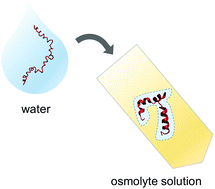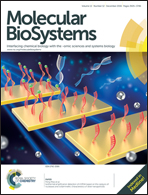Folding propensity of intrinsically disordered proteins by osmotic stress†
Abstract
Proteins imparted with intrinsic disorder conduct a range of essential cellular functions. To better understand the folding and hydration properties of intrinsically disordered proteins (IDPs), we used osmotic stress to induce conformational changes in nuclear co-activator binding domain (NCBD) and activator for thyroid hormone and retinoid receptor (ACTR) separate from their mutual binding. Osmotic stress was applied by the addition of small and polymeric osmolytes, where we discovered that water contributions to NCBD folding always exceeded those for ACTR. Both NCBD and ACTR were found to gain α-helical structure with increasing osmotic stress, consistent with their folding upon NCBD/ACTR complex formation. Using small-angle neutron scattering (SANS), we further characterized NCBD structural changes with the osmolyte ethylene glycol. Here a large reduction in overall size initially occurred before substantial secondary structural change. By focusing on folding propensity, and linked hydration changes, we uncover new insights that may be important for how IDP folding contributes to binding.



 Please wait while we load your content...
Please wait while we load your content...